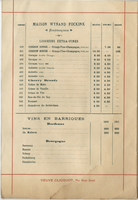Search the Special Collections and Archives Portal
Search Results
Underground House of Las Vegas Collection
Identifier
Abstract
The Underground House of Las Vegas Collection (1964-2004) consists of newspaper clippings, magazine articles, books, photographic prints, and digital images detailing the construction and history of Girard "Jerry" B. Henderson’s "Underground House," a Las Vegas underground dwelling completed in 1978.
Archival Collection
Las Vegas High School Class of 1929 Collection
Identifier
Abstract
The Las Vegas High School Class of 1929 Collection (1921-1979) contains materials relating to the Las Vegas High School graduating class of 1929. Materials include a scrapbook with photographs, pamphlets, fliers, and newspaper clippings from the thirtieth, fortieth, forty-fifth, and fiftieth reunions, as well as poster boards and oversized photographs from the 1920s.
Archival Collection
Artemus W. Ham Family Papers
Identifier
Abstract
The Artemus W. Ham Family Papers (1857-1970) contain postcards written by family members, newspaper clippings about the Ham family, and a Nevada Senate Concurrent Resolution memorializing Artemus W. Ham, Sr. Also included are genealogy notes, a commencement program from Michigan Law School, and membership cards of Artemus W. Ham, Sr.
Archival Collection
E. W. Smith Glass Plate Negatives
Identifier
Abstract
The E. W. Smith Glass Plate Negatives (approximately 1900-1916) contain original glass plate negatives created by E. W. Smith during his time in Tonopah, Manhattan, Goldfield, and other central Nevada mining towns in the early 1900s. All photographs are presumed to be taken by E. W. Smith unless noted otherwise in the inventory. The negatives were collected by Warren Virgil "Mac" McGowan, who along with his wife Hilda lived in Tonopah, Nevada from approximately 1930 to the 1960s. He was the town photographer and ran a store and boarding house located at what is now 111 N. Main Street in Tonopah.
Archival Collection
Cliff Segerblom Artwork
Identifier
Abstract
The Cliff Segerblom Artwork contains four pieces of Segerblom's artwork. One painting of a desert home in Nelson, Nevada titled "Afternoon in Nelson" from 1940, one drawing of the USS Hornet from 1969, and two watercolor paintings of Lake Mead and Sunrise Mountain. The First Annual Southern Nevada Art Exhibit originally displayed "Afternoon in Nelson" in Las Vegas, Nevada between January 27 and 28 in 1940. The USS Hornet drawing was created November 1969, depicting a fighter aircraft aboard the USS Hornet at Apollo 12's splashdown. The two watercolors were donated to the University in 1962 by the Clark County Panhellenic Association.
Archival Collection
Stewart, Helen Jane Wiser, 1854-1926
Helen Jane Wiser Stewart was born in 1854 in Springfield, Illinois. When she was nine years old, the family moved to Nevada, and then to Sacramento, California in 1863. Helen was educated in Sacramento and in 1873 she married Archibald Stewart in Stockton, California.
Person
Lake-Eglington Family Photograph Collection
Identifier
Abstract
The Lake-Eglington Family Photograph Collection contains photographs of the Lake-Eglington Family in and around Las Vegas, Nevada from 1900 to 1976. The materials include photographs of early Las Vegas resident Olive Lake-Eglington and her family shortly after they moved to Las Vegas in 1904, as well as her eventual husband Earle Eglington after he moved to Las Vegas in 1911. The materials also include photographs of Native American artifacts, schools in Clark County, Nevada, artesian wells, the Hoover (Boulder) Dam, the Colorado River, Mt. Charleston, the Mormon Fort, the Stewart (Kiel) Ranch, the Las Vegas Ranch, and many early residents of Las Vegas.
Archival Collection

